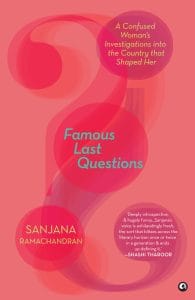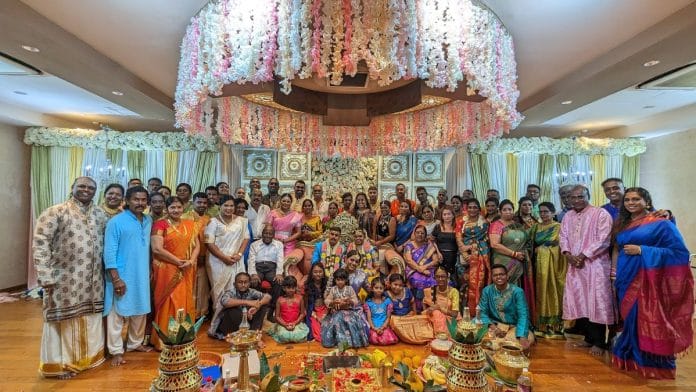At a recent, highly contemporary TamBrahm wedding, the morning’s Vedic rites and rituals were followed by an evening cocktail party. The marriage was arranged by the parents, but the children, both TamBrahms plucked from freshly graduated IIT–IIM stock, wanted to change the story because ‘arranged marriages are lame now’. This is a twist to the quintessential Indian tendency of too-much-parentalinvolvement-over-course-of-child’s-entire-life, because the children have now internalized methods that follow tradition but look modern.
So, marriages may be caste-bound and arranged, but on Instagram should look like ‘love’. This tension between wanting to look ‘modern’, ‘global’, ‘Western’, and ‘advanced’, while also remaining ‘traditional’ and ‘Indian’ ‘at heart’, has been a defining theme of life in contemporary India. After it liberalized its economy in 1991, entering a world evermore awash with identities and their abstractions across the internet, we are careful about all our appearances, working like full-time brand managers of the self, and, directly or otherwise, the country. At the wedding, Appa laughed off an invitation to drink stating that he had a hard time ‘controlling himself’, sounding more like a spent socialite than a camouflaged conservative. Amma then remarked that she had ‘always liked’ the inviter, a thirty-five-year-old unmarried man who was moving around with his drink in one hand and his girlfriend in another. Meanwhile, their daughter, now twenty-eight years old and also unmarried, had spent the evening fearfully, doing what she had always done: living hypocritically.
I had tried to hide everything. My secrets spanned not only social evils like my clothing and drinking and other ‘bad habits’—Appa’s umbrella term for my moral health—but also my deepest problems, the times I needed help the most, my likes and dislikes, my friendships and relationships, my aspirations, my whole self. Unlike characters in these Western movies and TV shows I watched—where parents knocked on their children’s doors, openly discussed sex and relationships, and seemed to understand their children emotionally, offering friendship, respect, and autonomy; where children and women were equals to adults and men—I gave up on the idea, growing up, that I could ever ‘be myself’ at home.
Like my family and everyone else I knew, I was wearing multiple masks all the time, alienated from myself and largely unaware of it. If ‘all the world’s a stage and each man in his time plays many a part’, as Shakespeare believed, Indians are prolific actors performing constantly for their families and loved ones.1 This may seem to be free work, but there is a cognitive payment for these double and triple lives. Hiding your sexuality, partner(s), true desires, careers, and lifestyle at home or work is not easy. There is a ‘constant feeling of having to choose between distinct versions…each feeling like a betrayal’; ‘As we seek acceptance from our families and society by trying to meet their standards, we move away from our true selves…and develop a kind of duality within us’; ‘Constant conflict within one’s mind…suppression of oneself can lead to identity crisis and depression in many’.
It can lead to madness if my life is true.
The ground between who we’d like to be, and who we choose to be, is sown with the seeds of our deepest conflicts— psychic, interpersonal, and societal—so much so that India’s best films and stories are about ordinary characters fighting to be themselves with those closest to them.
The results are mixed. In the 2016 Marathi film Sairat, an inter-caste couple is hunted down and murdered by their families for falling in love, getting married, having a child, and even trying to live away from the crime scene. In the 2015 Hindi film Masaan, cops in Varanasi ‘catch’ two lovers in a hotel room, driving the man to kill himself in the toilet. Stigma and shame follow the Brahmin woman he slept with, who contends with a hostile father and gossiping town afterwards. In The Newlyweds, Mansi Choksi writes about the couples who overcome inter-caste and inter-faith norms for their love, and whether it remains worth it after all.
Serious drama isn’t the only genre to tackle these obstacles to self-actualization, of course. In an Instagram reel on the ‘Three Signs of Childhood Trauma’, @vineeth_sri stops at ‘Sign #1: Having Indian parents’. Ankur Warikoo, a doyen of the Indian creator economy, wrote about the ‘11 things that Indian parents get wrong’, from ‘comparison’ and ‘looking at the world only through their own experiences’ and ‘emotional blackmail’ and ‘dismissing mental health’ to ‘unreasonable expectations’.5 One reel thus suggests that ‘healing from generational trauma together’ is one of the ‘Five Signs of a Loving Relationship’.
Controlling Indian parents are a favourite of ‘desi’ social media, which includes not only resident Indians but also the sizable diaspora the country has exported across the world. ‘Trauma’ became the word of the decade.7 Google searches for it peaked in 2022, and related terms like ‘cultural trauma’, ‘collective trauma’, ‘historical trauma’, and ‘intergenerational trauma’ have been on the rise since the 1990s—tongue-incheek references in pop culture and online are concomitant with its more serious usage.8 The term is at the altar of modern life’s assault on language. Most political crises today are debates over terms we’ve come to associate with structures we’d rather not live by anymore. But language is both our tool of communication and our tool of thought, so battles about language are battles within our minds.
The upper-caste, ‘privileged’ woman who cries ‘trauma!’ may well be left alone by the rest, especially if they’re her family, or if they’re on Twitter (currently X), or if they belong to more marginalized identities. After all, the virtuous and extremely online of the human race have invented the scientifically tested sliding scale for suffering, wherein your trauma can be calculated in neat proportion to your identity. Caste, class, religion, age, disability, sexuality—all these axes of identity are but variables for the polynomial equation that outputs How Much You Have Suffered, or How Legitimate Your Victimhood Is. It’s easy-to-use and available at a rotting online discourse near you.
According to this scale, your suffering is obviously the least if you’re a man—you could never have had hardships, of course—and it’s least-most if you’re a straight man, but not-so-least if you’re a queer man, unless you’re a queer man and of a marginalized caste or religion, but all of these are still inferior sufferings to women at large, unless, of course, you’re upper-caste women, because then you still have class privilege, but, if not, god save you, because you have it the worst-most. This is proven.
 This excerpt from Sanjana Ramachandran’s ‘Famous Last Questions’ has been published with permission from Aleph Book Company.
This excerpt from Sanjana Ramachandran’s ‘Famous Last Questions’ has been published with permission from Aleph Book Company.






